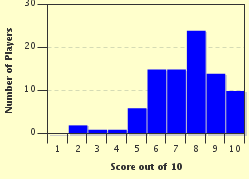Quiz Answer Key and Fun Facts
1. Around AD 60 this brave lady, a royal, rose up against the Romans and with an ever increasing Celtic army, destroyed three Roman towns and killed tens of thousands of Romans. What was the name of this warrior woman?
2. This lady's fight against slavery and later suffrage is well documented. She is one the United States' most revered civilians. She received many accolades and awards, most after her death, including one in 2016, when U.S. Treasury Secretary Jack Lew announced that she would replace Andrew Jackson (a former slave owner) on the American twenty dollar bill. Who was she?
3. Who was Israel's fourth Prime Minister with tenure between 1969 and 1974? She was known as the "Iron Lady" of Israeli politics long before Margaret Thatcher became the UK's Iron Lady.
4. This Australian lady was born in Western Australia in 1861. While she was the first women elected to any Australian parliament, she was also known for fighting for women and children's rights in an era where these values had very little level of public awareness. What is this lady's name?
5. A British suffragette (15 July 1858-14 June 1928) whose representations helped gain British women the right to vote was popularised by Meryl Streep in a 2015 movie. Who was this suffragette?
6. The 11th President of the Philippines had never held any form of political office before her appointment as President. How she achieved this is testimony to her courage and her loyalty to her country of birth. Who was she?
7. New Zealand, a country known for its individualism, had its fair share of rebels. One such lady led a march for Maori land rights from the north of the North Island to the capital in Wellington on its Southern tip in 1975. What was the name of this remarkable lady?
8. This Burmese lady was born near Rangoon (now Yangon) in 1945. She came to prominence in 1990 when her political party won over 80% of the vote but the poll was suppressed and not recognised. She was placed under house arrest for 15 of the next 21 years where she still campaigned for a free Burma. What is this Nobel Peace Prize winner's name?
9. Our next "Rebel" lady should perhaps better described as defiant. She was known for a single event in the US South in 1955 but in fact had a life long dedication to her cause. So well known, you need no further clues to establish her identity. Who was she?
10. No account of "rebellious" women would be complete without the inclusion of this young lady. All I need say is she was proclaimed a French martyr and she was wrongly sentenced to death for her deeds. She was around 19 when she died at the stake. What was her FIRST name?
Source: Author
1nn1
This quiz was reviewed by FunTrivia editor
bloomsby before going online.
Any errors found in FunTrivia content are routinely corrected through our feedback system.

